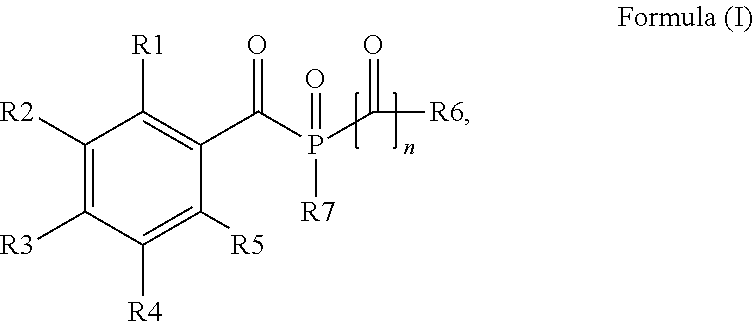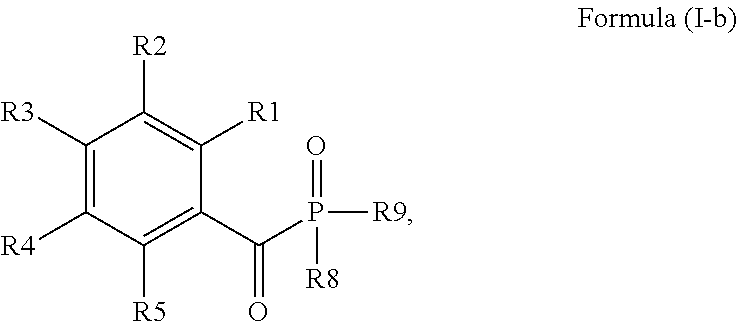Acylphosphine oxide photoinitiators
a technology of acylphosphine oxide and photoinitiators, which is applied in the direction of organic chemistry, inks, group 5/15 element organic compounds, etc., can solve the problems of enhancing the skin irritating character of the photoinitiator, limiting the formulation latitude in designing low viscosity ink jet inks, and giving an undesired background smell. , to achieve the effect of reducing the bad smell and reducing the handling in manufacturing
- Summary
- Abstract
- Description
- Claims
- Application Information
AI Technical Summary
Benefits of technology
Problems solved by technology
Method used
Image
Examples
example 1
[0257]This example illustrates the synthesis of APOTHIOL-4.
[0258]
Step 1: formation of (4-bromomethyl-2,6-dimethyl-phenyl)-(diphenyl-phosphinoyl)-methanone
[0259]10 g (28.7 mmol) (2,4,6-trimethylbenzoyl)diphenylphosphine oxide was dissolved in 100 ml chlorobenzene. 5.11 g (28.7 mmol)N-bromo-succinimid was added and the mixture was heated to 80° C. 0.23 g (1.2 mmol) WAKO V59 was added and the reaction was allowed to continue at 80° C. for 18 hours. The reaction mixture was allowed to cool down to room temperature. 150 ml ethyl acetate was added and the mixture was extracted twice with a mixture of 100 ml water and 50 ml brine. The organic fraction was dried over MgSO4 and evaporated under reduced pressure. (4-bromomethyl-2,6-dimethyl-phenyl)-(diphenyl-phosphinoyl)-methanone was purified using preparative column chromatography on a Prochrom™ LC80 column, using Kromasil™ Si60A 10 μm as stationary phase and hexane / ethyl acetate 50 / 50 as eluent. 2.8 g of (4-bromomethyl-2,6-d...
example 2
[0261]This example illustrates the synthesis of APOTHIOL-6.
[0262]
Step 1: formation of 3-nitro-2,4,6-trimethyl Benzoic Acid
[0263]50 g (0.3 mol) 2,4,6-trimethyl benzoic acid was suspended in 1390 g of a 65% solution of nitric acid. The mixture was stirred and 98.57 g sulphuric acid was added. The temperature rose to 40° C. The reaction was allowed to continue for 16 hours at room temperature. The mixture was slowly poured into 1500 g of an ice-water mixture. 3-nitro-2,4,6-trimethyl benzoic acid precipitated from the medium, was isolated by filtration and dried. 58.2 g (y:92.7%) of 3-nitro-2,4,6-trimethyl benzoic acid was isolated (m.p. 196° C.). 3-nitro-2,4,6-trimethyl benzoic acid was used without further purification.
Step 2: Formation of 3-nitro-2,4,5-trimethyl Benzoyl Chloride
[0264]15.69 g (75 mmol) 3-nitro-2,4,6-trimethyl benzoic acid was suspended in 150 ml toluene. 8.89 g (0.1125 mol) pyridine was added and the mixture was stirred for 10 minutes. 13.83 g (0.1125 m...
example 3
[0269]This example illustrates the synthesis of APOTHIOL-2.
[0270]
[0271]0.98 g (2 mmol) pentaerythritol tetrakis(3-mercaptopropionate) was dissolved in 40 ml methanol. 0.45 g (4.4 mmol) triethyl amine and 1.58 g (4 mmol) (4-bromomethyl-2,6-dimethyl-benzoyl)-phenyl-phosphinic acid ethyl ester were added and the reaction was allowed to continue for 48 hours at room temperature. The solvent was removed under reduced pressure and the residue was dissolved in 50 ml ethyl acetate. The precipitated salts were removed by filtration and the ethyl acetate fraction was extracted with 30 ma of a 0.1 M HCl solution and 20 ml brine. The organic fraction was dried over MgSO4 and evaporated under reduced pressure. 1.9 g of a mixture of thiol functionalized acyl phosphine oxide photoinitiators was isolated. The mixture of thiol functionalized acyl phosphine oxide initiators was analyzed using LC-MS.
[0272]The LC-MS analysis was performed on a YMC Aq column (50×2 mm, particle size 3 μm) ...
PUM
| Property | Measurement | Unit |
|---|---|---|
| Fraction | aaaaa | aaaaa |
| Fraction | aaaaa | aaaaa |
| Fraction | aaaaa | aaaaa |
Abstract
Description
Claims
Application Information
 Login to View More
Login to View More - R&D
- Intellectual Property
- Life Sciences
- Materials
- Tech Scout
- Unparalleled Data Quality
- Higher Quality Content
- 60% Fewer Hallucinations
Browse by: Latest US Patents, China's latest patents, Technical Efficacy Thesaurus, Application Domain, Technology Topic, Popular Technical Reports.
© 2025 PatSnap. All rights reserved.Legal|Privacy policy|Modern Slavery Act Transparency Statement|Sitemap|About US| Contact US: help@patsnap.com



